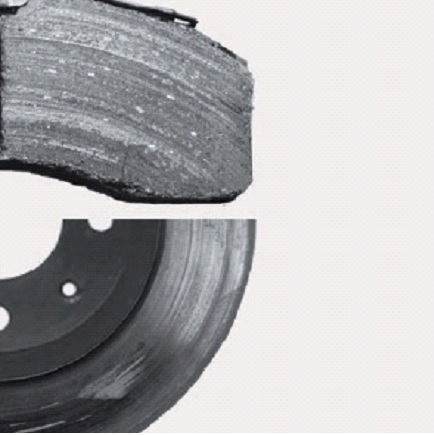The Metal Pick-Up (MPU) Problem You Can’t Ignore: Causes, Effects, and Solutions.
Case: Metal Spots Appear on the Surface of Brake Pads, Leading to Brake Noise and Disc Damage
The phenomenon shown in the picture is commonly referred to as Metal Pick-Up (MPU). It refers to iron particles with very high hardness embedded in the surface of the brake pad, forming a glittering, fish scale-like appearance (as shown in the figure below). This results in uneven friction, which can cause scratches on the brake disc (as shown in the figure) and may lead to brake noise and disc damage. The metal pick-up issue is a general problem, independent of the friction material manufacturer, and has been observed in both Low-Met and Ceramic formulas.

Cause Analysis:
- Uneven Pressure Transfer: The pressure from the brake caliper to the brake pad may be uneven, resulting in irregular contact between the pad and the disc. This leads to uneven wear and heat accumulation on the surface, which increases the probability of MPU formation.
- Issues with Ceramic Formulation: Generally, ceramic formulations have poor thermal conductivity and a low proportion of graphite (lubricating) materials. If the formulation is not properly designed, heat concentrates on the friction surface during braking. This can cause rapid carbonization of the adhesive layer (mainly phenolic resin) on the friction surface, preventing the formation of a lubricating transfer film. Under high-temperature and high-pressure conditions, local hard points accumulate during braking, increasing the chance of MPU.
- Presence of Hard Foreign Substances: During the manufacturing process of brake pads or discs, hard foreign particles may get mixed in. These particles may not be discharged during braking, leading to MPU formation.
- Material Composition of Brake Discs: Elements such as carbon (C) and silicon (Si) in the disc material, when scraped onto the friction surface, can carbonize under continuous high temperatures to form hard oxides. This further aggravates the MPU phenomenon.
- Rust Formation: If the vehicle is parked for a long time, serious rusting of the brake disc can occur. In such cases, rust may transfer to the brake pad or remain on the disc, increasing the chance of MPU and causing disc damage.
- High Ferrite Content in Brake Disc: Excessive ferrite content in the disc results in insufficient hardness. During braking, this can increase the likelihood of MPU.
Solutions:
- Check the Brake Calipers: Inspect the calipers for faults. If issues are found, repair or replace them as needed.
- Verify Ceramic Formulation: Ensure the ceramic formulation used is properly designed and qualified.
- Inspect for Foreign Substances: Check the surface of both brake pads and discs for hard foreign particles. Replace the affected components if any are found.
- Mild MPU Cases: If the MPU phenomenon is slight, continued use may naturally remove the metal particles on the pad surface, allowing the MPU to disappear on its own.
- Severe MPU Cases: If the MPU is severe and does not resolve with continued use, replace the brake pads. If the disc surface is badly scratched, replace the brake disc as well
